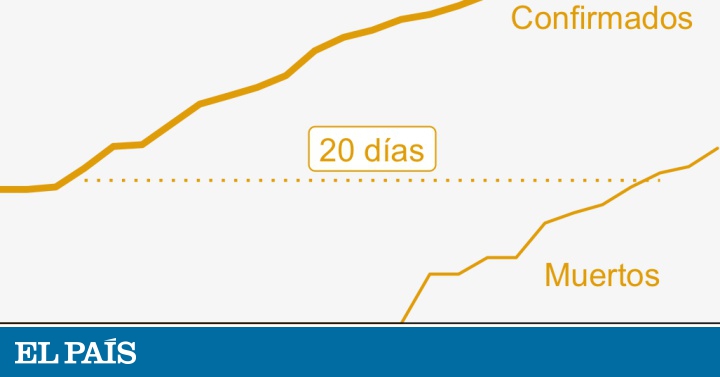Figures for the coronavirus in Germany hide an enigma: the country has 17,000 confirmed cases and only 44 deaths. That leaves a case fatality rate of 0.26%, much lower than that of France (2%), Spain (4%) and Italy (8%). We know that this difference is influenced by Germany's ability to do thousands of tests. But there must be something more. The German case fatality rate is also exceptionally low compared to South Korea (1%), whose diagnostic capacity is also considered high. How, then, is the German case explained? This Friday the spokesman for the Ministry of Health, Fernando Simón, said they do not know. And neither do the German authorities have a definitive explanation. But there are at least three hypotheses.
1. It is possible that the virus broke out in Germany later . The first local outbreak of contagion within Europe was detected in Italy and was well advanced when it emerged: that's why the dead got there quickly. Only a week passed from infected number 20 to dead number 20. That suggests that the outbreak had been active for weeks, because the disease takes two or three weeks to cause death.
Confirmed cases and deaths by country
The alarm in Italy caused European countries to redouble their detection efforts. In Spain, the detected cases of an outbreak that was actually already here multiplied.
The first cases were also detected in Germany, but its outbreak was surely in its early stages. “Germany recognized its outbreak very early. We go two or three weeks before some neighboring countries ”, explained the virologist Christian Drosten to Zeit. “We did it because we do many diagnoses, we test a lot. Certainly cases were passed to us in that first phase. But I don't think we missed a major outbreak. "
That could explain why its mortality rate is lower. For two reasons. First, because if Germany has detected the cases from the beginning, it will have detected more infected young people, who are the first to get infected (they travel more and have more contact with foreigners). Young people resist the virus better. Deaths are more common when the virus progresses and older people are infected.
The other reason is that deaths take time to occur. In many countries we have seen mortality rates rise over time. This is what happened in South Korea, where the tests are being exhaustive and mortality has doubled: it went from 0.5% to 1.1% between March 1 and March 20. If the outbreak in Germany is more recent than the outbreak in Spain or Germany, their lethality figures could increase.
2. The German sick are younger . In Germany, the age of a sample of those infected is published daily, so we know that their average age is 47 years and that only 20% are over 60 years old. These figures are similar to those of Korea (I), but very different from those of Italy, where the average age of those infected - which are detected - is 66 years old and where 58% are over 60 years old (I). Older Covid-19 sufferers are higher-risk cases. Each country's population pyramid could also play a role. Italy is the European country with the over 65s (26%), while in Korea they are only 14%. But that does not help explain the German case, where 25% of people are 65 years or older.
Cultural factors may also weigh. Data from China say that between 75% and 80% of Covid-19 infections have occurred in family nuclei, WHO's Bruce Aylward told The New York Times. But the daily contact between young and old is not the same in all societies. As Moritz Kuhn of the University of Bonn (Germany) suggests, people between 30 and 49 years old who live with their parents exceed 20% in Italy, China or Japan, while in Germany they are just over 10%.
3. Behind it all are the tests. Germany has ensured through the Robert Koch Institute, the center responsible for disease control, that it can do 160,000 tests a week. The country could have done up to 4,000 tests per million people, very far from the 625 per million that Spain has done. It is evident that better detection reduces crude case fatality rates to bring them closer to reality: if you count all infections - including the mildest ones - the ratio of deaths to infected will be lower.
This is also what the numbers for South Korea suggest. It is the country that has done the most tests (more than 5,000 per million inhabitants), and although its outbreak has been around for quite a few weeks, it is still one of the countries with the lowest lethality, 1.1%, which is often used as a reference.
The low lethality of the virus in Germany is likely due to a mixture of several things. Its figures will probably continue far from those of Spain and Italy, as long as the country continues to be able to test massively. But if another factor is that your outbreak is at an earlier stage, your death toll will rise and lethality will rise. The question is how much.













